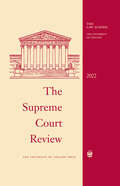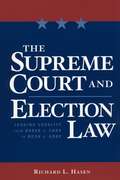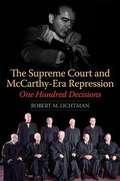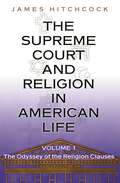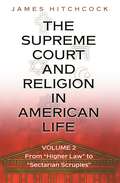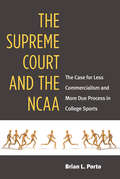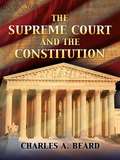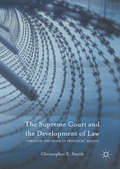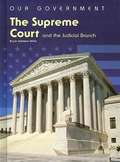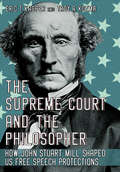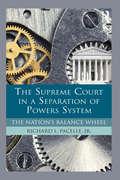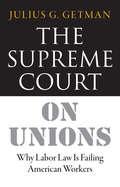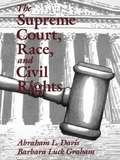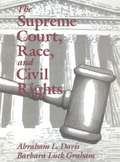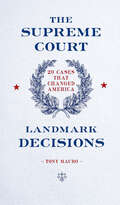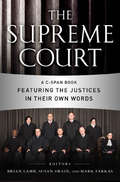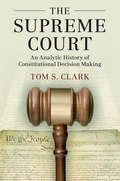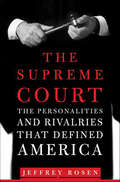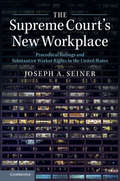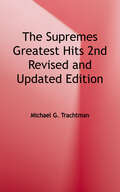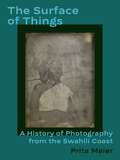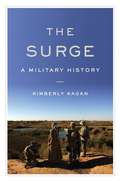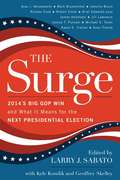- Table View
- List View
The Supreme Court Review, 2022 (Supreme Court Review)
by The University of Chicago PressAn annual peer-reviewed law journal covering the legal implications of decisions by the Supreme Court of the United States. Since it first appeared in 1960, the Supreme Court Review has won acclaim for providing a sustained and authoritative survey of the implications of the Court's most significant decisions. SCR is an in-depth annual critique of the Supreme Court and its work, analyzing the origins, reforms, and modern interpretations of American law. SCR is written by and for legal academics, judges, political scientists, journalists, historians, economists, policy planners, and sociologists.
The Supreme Court and Election Law: Judging Equality from Baker v. Carr to Bush v. Gore
by Richard Hasen&“A pioneering study of the Court&’s increasing efforts to regulate the US political system&” from the author of A Real Right to Vote (Bruce Cain, University of California, Berkeley). In the first comprehensive study of election law since the Supreme Court decided Bush v. Gore, Richard L. Hasen rethinks the Court&’s role in regulating elections. Drawing on the case files of the Warren, Burger, and Rehnquist courts, Hasen roots the Court&’s intervention in political process cases to the landmark 1962 case, Baker v. Carr. The case opened the courts to a variety of election law disputes, to the point that the courts now control and direct major aspects of the American electoral process. The Supreme Court does have a crucial role to play in protecting a socially constructed &“core&” of political equality principles, contends Hasen, but it should leave contested questions of political equality to the political process itself. Under this standard, many of the Court&’s most important election law cases from Baker to Bush have been wrongly decided. &“A must-read for anyone interested in the intersection of law and politics . . . [Hasen&’s] is an important framework against which election law scholars will react and upon which they will build for some time to come.&” —Michigan Law Review &“Hasen engagingly draws on internal Court deliberations, as well as political science and legal theory, to assess and criticize dramatic transformations in the role of constitutional law in overseeing the structure of democracy.&” —Richard H. Pildes, NYU School of Law &“A major contribution to the field of election law.&” —Thomas E. Mann, The Brookings Institution
The Supreme Court and McCarthy-Era Repression: One Hundred Decisions
by Robert M. LichtmanThe 1950s "Red Scare" marks one of the stormiest periods in U.S. Supreme Court history. Robert M. Lichtman provides the definitive history of the high court's decisions in every one of the "Communist" cases it decided, placing each within the context of the time and revealing the broad range and impact of McCarthy-era repression. Making extensive use of the justices' papers, Lichtman examines the dynamics of the Court's changes in direction, from the Vinson Court's rubber-stamping of government action against subversives to the Warren Court's more liberal rulings and the subsequent retreat led by Felix Frankfurter. Lichtman's account details the Court's surprising vulnerability to popular and political attack and reveals the behind-the-scenes relationships and rivalries among justices. At the same time, he recounts in devastating detail the injuries inflicted by McCarthyism on individuals and the nation.
The Supreme Court and Religion in American Life, Vol. 1: The Odyssey of the Religion Clauses (New Forum Books #33)
by James HitchcockSchool vouchers. The Pledge of Allegiance. The ban on government grants for theology students. The abundance of church and state issues brought before the Supreme Court in recent years underscores an incontrovertible truth in the American legal system: the relationship between the state and religion in this country is still fluid and changing. This, the first of two volumes by historian and legal scholar James Hitchcock, provides the first comprehensive exploration of the Supreme Court's approach to religion, offering a close look at every case, including some that scholars have ignored. Hitchcock traces the history of the way the Court has rendered important decisions involving religious liberty. Prior to World War II it issued relatively few decisions interpreting the Religious Clauses of the Constitution. Nonetheless, it addressed some very important ideas, including the 1819 Dartmouth College case, which protected private religious education from state control, and the Mormon polygamy cases, which established the principle that religious liberty was restricted by the perceived good of society. It was not until the 1940s that a revolutionary change occurred in the way the Supreme Court viewed religion. During that era, the Court steadily expanded the scope of religious liberty to include many things that were probably not intended by the framers of the Constitution, and it narrowed the permissible scope of religion in public life, barring most kinds of public aid to religious schools and forbidding almost all forms of religious expression in the public schools. This book, along with its companion volume, From "Higher Law" to "Sectarian Scruples," offers a fresh analysis of the Court's most important decisions in constitutional doctrine. Sweeping in range, it paints a detailed picture of the changing relationship between religion and the state in American history.
The Supreme Court and Religion in American Life, Vol. 2: From "Higher Law" to "Sectarian Scruples" (New Forum Books #34)
by James HitchcockSchool vouchers. The Pledge of Allegiance. The ban on government grants for theology students. The abundance of church and state issues brought before the Supreme Court in recent years underscores an incontrovertible truth in the American legal system: the relationship between the state and religion in this country is still fluid and changing. This, the second of two volumes by historian and legal scholar James Hitchcock, offers a complete analysis and interpretation of the Court's historical understanding of religion, explaining the revolutionary change that occurred in the 1940s. In Volume I: The Odyssey of the Religion Clauses (Princeton), Hitchcock provides the first comprehensive survey of the court cases involving the Religion Clauses, including a number that scholars have ignored. Here, Hitchcock examines how, in the early history of our country, a strict separation of church and state was sustained through the opinions of Jefferson and Madison, even though their views were those of the minority. Despite the Founding Fathers' ideas, the American polity evolved on the assumption that religion was necessary to a healthy society, and cooperation between religion and government was assumed. This view was seldom questioned until the 1940s, notes Hitchcock. Then, with the beginning of the New Deal and the appointment of justices who believed they had the freedom to apply the Constitution in new ways, the judicial climate changed. Hitchcock reveals the personal histories of these justices and describes how the nucleus of the Court after World War II was composed of men who were alienated from their own faiths and who looked at religious belief as irrational, divisive, and potentially dangerous, assumptions that became enshrined in the modern jurisprudence of the Religion Clauses. He goes on to offer a fascinating look at how the modern Court continues to grapple with the question of whether traditional religious liberty is to be upheld.
The Supreme Court and The NCAA: The Case for Less Commercialism and More Due Process in College Sports
by Porto Brian L.Two Supreme Court decisions,NCAA v. Board of Regents(1984) andNCAA v. Tarkanian(1988), have shaped college sports by permitting the emergence of a supercharged commercial enterprise with high financial stakes for institutions and individuals, while failing to guarantee adequate procedural protections for persons charged with wrongdoing within that enterprise. Brian L. Porto examines the conditions that led to the cases, the reasoning behind the justices' rulings, and the consequences of those rulings. Arguing that commercialized college sports should be compatible with the goals of higher education and fair to all participants, Porto suggests that the remedy is a federal statute. His proposed College Sports Legal Reform Act would grant the NCAA a limited "educational exemption" from the antitrust laws, enabling it to enhance academic opportunities for athletes. The Act would also afford greater procedural protections to accused parties in NCAA disciplinary proceedings. Porto's prescription for reform in college sports makes a significant contribution to the debate about how best to address perennial problems in college sports such as cost containment, access to a meaningful education for athletes, and fairness in rule enforcement.
The Supreme Court and the Attitudinal Model Revisited
by Jeffrey A. Segal Harold J. SpaethThis book, authored by two leading scholars of the Supreme Court and its policy making, systematically presents and validates the use of the attitudinal model to explain and predict Supreme Court decision making. In the process, it critiques the two major alternative models of Supreme Court decision making and their major variants: the legal and rational choice. Using the US Supreme Court Data Base, the justices' private papers, and other sources of information, the book analyzes the appointment process, certiorari, the decision on the merits, opinion assignments, and the formation of opinion coalitions. The book will be the definitive presentation of the attitudinal model as well as an authoritative critique of the legal and rational choice models. The book thoroughly reflects research done since the 1993 publication of its predecessor, as well as decisions and developments in the Supreme Court, including the momentous decision of Bush v. Gore.
The Supreme Court and the Constitution
by Charles A. BeardA thorough analysis of the early history and development of judicial review, this is one of the most cited and highly regarded texts on law and government. Author Charles A. Beard ranks among the twentieth century's preeminent judicial and constitutional scholars. His enlightening and accessible survey examines the U.S. high court's role in interpreting and enforcing the laws of the country's framing documents. It addresses the controversies surrounding the exercise of judicial power, and it dismisses charges of the Supreme Court's usurpation of judicial review powers.Beard explores the intentions of the constitution's framers by delving into the records of the Constitutional Convention of 1787 and the text of the constitution itself. He places information from these sources into the context of colonial and republican American life, drawing upon memoirs and correspondence of the day for further insights. This edition of his work is supplemented by an appendix and bibliographies, along with an extensive Introduction, "Charles Beard and the American Debate Over Judicial Review, 1790-1961." Students and scholars of political science, history, and law will find this book an indispensable addition to their libraries.
The Supreme Court and the Development of Law
by Christopher E. SmithThis book illuminates the decision-making processes of the US Supreme court through an examination of several prisoners' rights cases. In 1964, the Supreme Court declined to hear prisoners' claims about religious freedom. In 2014, the Supreme Court heard a case that led to the justices' unanimous endorsement of a Muslim prisoner's religious right to grow a beard despite objections from prison officials. In the fifty-year span between those two events, the Supreme Court developed the law concerning rights for imprisoned offenders. As demonstrated in this book, the factors that shape Supreme Court decision making are well-illustrated by prisoners' rights cases. This area of law illuminates competing approaches to constitutional interpretation, behind-the-scenes interactions among the justices, and the manipulation of legal precedents. External actors also affect the Supreme Court and its decisions when the president appoints new justices and Congress targets the judiciary with legislative enactments. Because of the controversial nature of prisoners' rights issues, these cases serve to illuminate the full array of influences over Supreme Court decision making.
The Supreme Court and the Judicial Branch (Our Government)
by Bryon Giddens-WhiteThis title presents an exciting look inside the judicial branch of the United States government. The book explores topics such as the origins of the judicial branch, the powers and day-to-day responsibilities of Supreme Court justices, historic Supreme Court decisions, and how the judicial branch has shaped the direction of our country.
The Supreme Court and the Philosopher: How John Stuart Mill Shaped US Free Speech Protections
by Eric T. Kasper Troy A. KozmaThe Supreme Court and the Philosopher illustrates how the modern US Supreme Court has increasingly adopted a view of the constitutional right to the freedom of expression that is classically liberal in nature, reflecting John Stuart Mill's reasoning in On Liberty. A landmark treatise outlining the merits of limiting governmental and social power over the individual, On Liberty advocates for a maximum protection of human freedom. Proceeding case by case and covering a wide array of issues, such as campaign finance, offensive speech, symbolic speech, commercial speech, online expression, and false statements, Eric T. Kasper and Troy A. Kozma show how the Supreme Court justices have struck down numerous laws for infringing on the freedom of expression.Kasper and Kozma demonstrate how the adoption of Mill's version of free speech began with Justice Oliver Wendell Holmes Jr. more than a century ago and expanded over time to become the prevailing position of the Court today. The authors argue that this embrace of Mill's rationale has led to an unmistakable reorientation in the Court's understanding of free expression jurisprudence.The Supreme Court and the Philosopher is the first book to comprehensively explore how the political philosophy of Mill has influenced the highest court in the land. In targeting the underlying philosophical reasons that explain why the modern Supreme Court renders its First Amendment decisions, this book is particularly timely, as the issues of censorship and freedom of expression are debated in the public square today.
The Supreme Court in a Separation of Powers System: The Nation's Balance Wheel
by Richard PacelleThe U.S. Supreme Court is not a unitary actor and it does not function in a vacuum. It is part of an integrated political system in which its decisions and doctrine must be viewed in a broader context. In some areas, the Court is the lead policy maker. In other areas, the Court fills in the gaps of policy created in the legislative and executive branches. In either instance, the Supreme Court’s work is influenced by and in turn influences all three branches of the federal government as well as the interests and opinions of the American people. Pacelle analyzes the Court’s interaction in the separation of powers system, detailing its relationship to the presidency, Congress, the bureaucracy, public opinion, interest groups, and the vast system of lower courts. The niche the Court occupies and the role it plays in American government reflect aspects of both the legal and political models. The Court has legal duties and obligations as well as some freedom to exercise its collective political will. Too often those studying the Court have examined it in isolation, but this book urges scholars and students alike to think more broadly and situate the highest court as the "balance wheel" in the American system.
The Supreme Court in the Intimate Lives of Americans: Birth, Sex, Marriage, Childrearing, and Death
by Howard BallPersonal rights, such as the right to procreate--or not-- and the right to die generate dendless debate. Howard Ball shows how the Supreme Court has grappled with the right to reproduce and abort, and takes on the issue of auto-euthanasia and assisted suicide, from Karen Ann Quinlan through Kevorkian and just recently to the Florida case of the women who was paralyzed by a gunshot from her mother and who had pulled the plug on herself. For the last half of the twentieth century, the justices of the Supreme Court have had to wrestle with new and difficult life and death questions for them as well as for doctors and their patients, medical ethicists, sociologists, medical practitioners, clergy, philosophers, law makers and judges. This book offers a look at these issues as they emerged and examines the manner in which the men and women of the U.S Supreme Court adressed them.
The Supreme Court on Unions: Why Labor Law Is Failing American Workers
by Julius G. GetmanLabor unions and courts have rarely been allies. From their earliest efforts to organize, unions have been confronted with hostile judges and antiunion doctrines. In this book, Julius G. Getman argues that while the role of the Supreme Court has become more central in shaping labor law, its opinions betray a profound ignorance of labor relations along with a persisting bias against unions. In The Supreme Court on Unions, Getman critically examines the decisions of the nation's highest court in those areas that are crucial to unions and the workers they represent: organizing, bargaining, strikes, and dispute resolution. As he discusses Supreme Court decisions dealing with unions and labor in a variety of different areas, Getman offers an interesting historical perspective to illuminate the ways in which the Court has been an influence in the failures of the labor movement. During more than sixty years that have seen the Supreme Court take a dominant role, both unions and the institution of collective bargaining have been substantially weakened. While it is difficult to measure the extent of the Court’s responsibility for the current weak state of organized labor and many other factors have, of course, contributed, it seems clear to Getman that the Supreme Court has played an important role in transforming the law and defeating policies that support the labor movement.
The Supreme Court, Race, and Civil Rights
by Abraham L. Davis Barbara Luck GrahamThis text brings examination and analysis of the Supreme Court's role in civil rights, race, and the law into the 21st century with a multidisciplinary, multiperspective approach. It incorporates information from the disciplines of law, political science, and history; provides an analysis of race and law from the perspective of politically disadvantaged groups and brings together Supreme Court readings vital to the understanding of the continuing evolution of civil rights in the United States.
The Supreme Court, Race, and Civil Rights: From Marshall to Rehnquist
by Abraham L. Davis Barbara Luck GrahamProviding a well-rounded presentation of the constitution and evolution of civil rights in the United States, this book will be useful for students and academics with an interest in civil rights, race and the law. Abraham L Davis and Barbara Luck Graham's purpose is: to give an overview of the Supreme Court and its rulings with regard to issues of equality and civil rights; to bring law, political science and history into the discussion of civil rights and the Supreme Court; to incorporate the politically disadvantaged and the human component into the discussion; to stimulate discussion among students; and to provide a text that cultivates competence in reading actual Supreme Court cases.
The Supreme Court: 20 Cases that Changed America
by Tony MauroA concise, informative guide to the twenty most momentous Court rulings in American history, including excerpts from the written decisions and dissents. The legislative branch of government creates laws, and the executive branch signs and enforces them. But how does America make sure these laws don’t run afoul of the Constitution? That responsibility lies with the final arbiters: the nine justices of the Supreme Court. Every year, thousands of contentious cases are submitted to the court; only about eighty of them are heard. Out of those cases, many are remembered only by the people directly involved. But over the years, many cases heard by the Supreme Court have gone on to affect the lives of many, or even all, American citizens. In The Supreme Court: Landmark Decisions, veteran court reporter Tony Mauro picks out the twenty most momentous Supreme Court cases in United States history. In his reviews, from Marbury v. Madison, the 1803 case that first affirmed the Supreme Court’s status as the country’s final legal arbiter, to Obergefell v. Hodges, the 2015 case that legalized same-sex marriage, Mauro summarizes each case and includes cogent summaries of the justices’ decisions, as well as notable dissents. From a journalist noted by the New York Times for “explaining complex legal issues to laymen without sacrificing accuracy and subtlety,” The Supreme Court: Landmark Decisions serves as your quick, concise, and informative guide to one of the most important, and sometimes least-understood, institutions in the nation.
The Supreme Court: A C-SPAN Book Featuring the Justices in their Own Words
by Brian Lamb Susan Swain C-Span Mark FarkasThe Supreme Court grew out of an historic opportunity to interview all of the living Supreme Court justices for a C-SPAN feature documentary about the Court, the only time that the nine sitting members and their retired colleagues have granted interviews to a single television network. Eleven of those interviews-the entire current court, including the newest member, Justice Elena Kagan-are gathered here in this singular collection. In their conversations with the justices, Brian Lamb and Susan Swain bring readers into a fascinating world to which few have had access. Chief Justice John Roberts talks about the role of the Court in society, his role as chief justice, and the process of deciding cases. Justice Stephen Breyer takes us on a private tour of his chambers and describes the differences between the Court and the Congress. And new Justices Sonia Sotomayor and Elena Kagan reflect on their first impressions of the job. Through these encounters, the justices' personalities, intellects, and devotion to the Court emerge. Enriching this material are Mark Farkas's interviews with journalists, court historians, and other experts on the Court. Reporters Joan Biskupic and Lyle Denniston discuss the Supreme Court in action and the impact of a new member of the Court. Clerk of the Supreme Court William Suter illuminates the traditions of the Court. Historian James O'Hara discusses the Supreme Court building and its history. Former Solicitor General Drew Days III and attorney Maureen Mahoney describe the experience of facing the justices in fast-paced oral arguments. The Supreme Court offers readers a rare window into the nation's highest court through the eyes of those who serve there. It is absorbing reading for anyone interested in this vital and powerful institution.
The Supreme Court: An Analytic History of Constitutional Decision Making (Political Economy of Institutions and Decisions)
by Tom S. ClarkThis book presents a quantitative history of constitutional law in the United States and brings together humanistic and social-scientific approaches to studying law. Using theoretical models of adjudication, Tom S. Clark presents a statistical model of law and uses the model to document the historical development of constitutional law. Using sophisticated statistical methods and historical analysis of court decisions, the author documents how social and political forces shape the path of law. Spanning the history of constitutional law since Reconstruction, this book illustrates the way in which the law evolves with American life and argues that a social-scientific approach to the history of law illuminates connections across disparate areas of the law, connected by the social context in which the Constitution has been interpreted.
The Supreme Court: The Personalities and Rivalries That Defined America
by Jeffrey RosenA leading Supreme Court expert recounts the personal and philosophical rivalries that forged our nation's highest court and continue to shape our daily livesThe Supreme Court is the most mysterious branch of government, and yet the Court is at root a human institution, made up of very bright people with very strong egos, for whom political and judicial conflicts often become personal.In this compelling work of character-driven history, Jeffrey Rosen recounts the history of the Court through the personal and philosophical rivalries on the bench that transformed the law—and by extension, our lives. The story begins with the great Chief Justice John Marshall and President Thomas Jefferson, cousins from the Virginia elite whose differing visions of America set the tone for the Court's first hundred years. The tale continues after the Civil War with Justices John Marshall Harlan and Oliver Wendell Holmes, who clashed over the limits of majority rule. Rosen then examines the Warren Court era through the lens of the liberal icons Hugo Black and William O. Douglas, for whom personality loomed larger than ideology. He concludes with a pairing from our own era, the conservatives William H. Rehnquist and Antonin Scalia, only one of whom was able to build majorities in support of his views.Through these four rivalries, Rosen brings to life the perennial conflict that has animated the Court—between those justices guided by strong ideology and those who forge coalitions and adjust to new realities. He illuminates the relationship between judicial temperament and judicial success or failure. The stakes are nothing less than the future of American jurisprudence.
The Supreme Court’s New Workplace: Procedural Rulings and Substantive Worker Rights in the United States
by Joseph A. SeinerThe US Supreme Court has systematically eroded the rights of minority workers through subtle changes in procedural law. This accessible book identifies and describes how the Supreme Court's new procedural requirements create legal obstacles for civil-rights litigants, thereby undermining their substantive rights. Seiner takes the next step of providing a framework that practitioners can use to navigate these murky waters, allowing workers a better chance of prevailing with their claims. Seiner clearly illustrates how to effectively use his framework, applying the proposed model to one emerging sector - the on-demand industry. Many minority workers now face pervasive discrimination in an uncertain legal environment. This book will serve as a roadmap for successful workplace litigation and a valuable resource for civil-rights research. It will also spark a debate among scholars, lawyers, and others in the legal community over the use of procedure to alter substantive worker rights.
The Supremes' Greatest Hits: The 44 Supreme Court Cases That Most Directly Affect Your Life
by Michael G. TrachtmanCan the government seize your house to build a shopping mall? Can it determine what control you have over your own body? Can police search your cellphone? <p><p>The answers to those questions come from the Supreme Court, whose rulings have shaped American life and justice and allowed Americans to retain basic freedoms such as privacy, free speech, and the right to a fair trial. <p><p>Especially relevant in light of Justice Antonin Scalia's passing, as President Obama gears for a fight over nominating his successor, and as we prepare to elect a new president who may get to appoint other justices, the revised and updated edition of Michael G. Trachtman's page-turner includes ten important new cases from 2010 to 2015. In addition, a special section features analyses of the new term rulings planned for June 2016.
The Surface of Things: A History of Photography from the Swahili Coast
by Prita MeierThe first major history of photography from coastal East AfricaThe ports of the Swahili coast—Zanzibar and Mombasa among them—have long been dynamic centers of trade where diverse peoples, ideas, and materials converge. With the arrival of photography in the mid-nineteenth century, these predominantly Muslim coastal communities cultivated and transformed the medium. The Surface of Things examines the complex maritime dynamics that shaped the photography of coastal Africa, exploring the pleasure and power of beautiful things and the ways people and their pictures transcended the boundaries of the colonial world.Immersing readers in the globally interconnected networks of eastern Africa&’s port cities, Prita Meier demonstrates how photographs are not static images but mobile objects with remarkable shape-shifting qualities. Beginning with the earliest photographs introduced through seaborne commerce, the medium&’s integration into the cultural landscape was swift. Photographs functioned as objects of decoration, good taste, and cosmopolitanism, but were also used by local elites and foreigners to coerce and objectify enslaved people. Meier uncovers the oppressive agenda behind postcards and other popular images while describing African strategies of subversion and rebellion, revealing the performative authority that individuals exerted over their photographic likenesses.Featuring more than two hundred images published here for the first time, The Surface of Things repositions the continent&’s islands and archipelagos at the center of global photographic histories and shows how the people of the African Indian Ocean world experienced photography as a force of both oppression and freedom.
The Surge
by Kimberly KaganUnderstanding the role of combat in the Iraq war is essential for both the American people and the U.S. military. Recognizing the objectives of both sides and the plans developed to attain those objectives provides the context for understanding the war. The Surge is an effort to provide such a framework to help understand not only where we have been, but also what happens as we move forward.
The Surge: The Big 2014 Gop Win and What It Means For the Next Presidential Election
by Larry J. Sabato Alan I. Abramowitz Jill Lawrence Joshua T. Putnam Geoffrey Skelley Michael E. Toner Karen E. Trainer Sean Trende Mark Blumenthal Jamelle Bouie Rhodes Cook Robert Costa Ariel Edwards-Levy James Hohmann Kyle KondikThe 2014 midterm election was one of the most significant in recent memory, with a decisive turning of the tables in favor of Republicans. With a now-Republican-controlled Senate and House at odds with a Democratic president with only two years left in office, the fault lines within and between both parties have never been more tenuous. In this book, prominent elections scholar and political commentator Larry J. Sabato brings together respected journalists and experts from across the political spectrum to examine every facet of the midterm election results and the implications for the 2016 election cycle. In frank, accessible prose, each author offers insight that goes beyond the headlines to analyze what the midterm results mean and what is at stake in the coming presidential race. Contributions by: Alan I. Abramowitz, Mark Blumenthal, Jamelle Bouie, Rhodes Cook, Robert Costa, Ariel Edwards-Levy, James Hohmann, Jill Lawrence, Joshua T. Putnam, Michael E. Toner, Karen E. Trainer, Sean Trende
